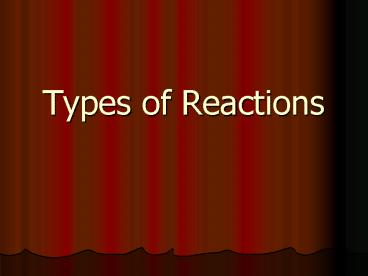Types of Reactions - PowerPoint PPT Presentation
1 / 25
Title:
Types of Reactions
Description:
Also true with oxygen containing derivatives. CH3OH O2 CO2 H2O ... Bismuth. Copper. Silver. Mercury. Platinum. Gold. The Activity Series of the Halogens ... – PowerPoint PPT presentation
Number of Views:101
Avg rating:3.0/5.0
Title: Types of Reactions
1
Types of Reactions
2
Combustion
- Produce a flame
- Hydrocarbons react with oxygen to produce
- CO2 H2O
- Also true with oxygen containing derivatives
- CH3OH O2 ? CO2 H2O (unbalanced)
3
- the cmpnd contains product will be
- a metal the metal oxide
- carbon carbon dioxide, CO2
- hydrogen water, H2O
- sulfur sulfur dioxide, SO2
Solid copper (II) sulfide is heated strongly in
oxygen gas CuS O2 ? CuO SO2 Carbon
disulfide vapor is burned in excess oxygen. CS2
O2 ? CO2 SO2 Ethanol is completely burned in
air. C2H5OH O2 ? CO2 H2O
4
Decomposition
- One substance undergoes a reaction to produce two
or more substances - Often occurs when heated
- Metal Oxides ? free metal O2
- ? metal oxide O2
- Metal carbonates ? metal oxide CO2
- H2CO3 ? H2O CO2
- Chlorates ? metalchloride Oxygen
- KClO3 ? KCl O2
5
Complexation Ligands
- Each type of metal ion has a characteristic
coordination number - Ag 2 (monodentate) ligands
- Zn2 and Cu2 4 ligands
- Al3 and Fe3 6 ligands.
- ligands refers to of complexes
6
Ammonia, NH3
- A concentrated solution of ammonia is added to a
solution of copper (II) chloride. - Cu2 NH3 ? Cu(NH3)42
- Ammonia complexes can be broken by adding acid to
form the ammonia ion - Dilute hydrochloric acid is added to a solution
of diamminesilver (I) nitrate. - H Cl- Ag(NH3)2 ? NH4 AgCl
7
Thiocyanate, SCN-
- Thiocyanate forms a dark red complex with iron,
Fe3 - A solution of ammonium thiocyanate is added to a
solution of iron (III) chloride. - Fe3 SCN- ? Fe(SCN)63-
8
Thiosulfate, S2O32-
- Thiosulfate forms complexes with any metal ions
- A solution of sodium thiosulfate is added to a
precipitate of silver iodide. - AgI S2O32- ? Ag(S2O3)23- I-
9
Single Dis/Replacement
- Replacement of
- Metals by another metal
- Hydrogen in water by a metal
- Hydrogen in an acid by a metal
- Halogens by more active halogens
10
The Activity Series of the Metals Lithium
Potassium Barium Calcium Sodium
Magnesium Aluminum Zinc Chromium Iron
Cobalt Nickel Tin Lead Hydrogen
Bismuth Copper Silver Mercury
Platinum Gold
- Metals can replace other metals provided that
they are above the metal that they are trying to
replace. - Metals above hydrogen can replace hydrogen in
acids. - Metals from sodium upward can replace hydrogen in
water
11
(No Transcript)
12
(No Transcript)
13
(No Transcript)
14
(No Transcript)
15
The Activity Series of the Halogens
Fluorine Chlorine Bromine Iodine
- Halogens can replace other halogens in compounds,
provided that they are above the halogen that
they are trying to replace. - 2NaCl(s) F2(g) ? 2NaF(s) Cl2(g)
- MgCl2(s) Br2(g) ? No Reaction
16
Products that decompose
- H2CO3 ? H2O CO2
- H2SO3 ? H2O SO2
- NH4OH ? H2O NH3
17
Double Replacement Reactions
- The ions of two compounds exchange places in an
aqueous solution to form two new compounds. - AX BY ? AY BX
- One of the compounds formed is usually a
precipitate (an insoluble solid), an insoluble
gas that bubbles out of solution, or a molecular
compound, usually water.
18
Occur in aqueous solns
- Solns with water
- The polarity of water creates dipole-ion
interactions to dissolve ionic compounds - Process is called hydration
- Tends to cause salts to fall apart in water
- Dissolved ions become hydrated (surrounded by
water molecules) and move around independently. - The degree to which dissolving occurs is a
substances solubility (g/100mL)
19
Solubility
- Degree of solubility depends on the strength of
attractive forces of ions in solution - Use rules (much be memorized ?) to predict
products of reactions - Remember like dissolves like
- polar molecules dissolve in water because of
h-bonds and dipole interactions
20
Exceptions
Salts
21
Precipitation Reactions
- When 2 solns are mixed, an insoluble product is
sometimes formed. - Solid forms from two liquids
- SolidPrecipitate
If youre not part of the solution youre part of
the precipitate.
22
Double replacement forming a precipitate
Double replacement (molecular) equation
Pb(NO3)2(aq) 2KI(aq) ? PbI2(s) 2KNO3(aq)
Complete Ionic Equation shows compounds as
aqueous ions
Pb2(aq) 2 NO3-(aq) 2 K(aq) 2 I-(aq) ?
PbI2(s) 2K(aq) 2 NO3-(aq)
Net Ionic Equation eliminates the spectator ions
Pb2(aq) 2 I-(aq) ? PbI2(s)
23
Complete the following
- K2CrO4(aq) Ba(NO3)2(aq) ? ???
- Split the reactants into ions
- 2K(aq) CrO4-2(aq) Ba2(aq) 2 NO3-(aq) ?
- BaCrO4 2KNO3-
- Separate soluble compounds
- 2K(aq) CrO4-2(aq) Ba2(aq) 2 NO3-(aq) ?
- BaCrO4(s) 2K(aq) 2 NO3-(aq)
24
- Eliminate spectator ions
- 2K(aq) CrO4-2(aq) Ba2(aq) 2 NO3-(aq) ?
- BaCrO4(s) 2K(aq) 2
NO3-(aq) - Write the Net Ionic Equation
- CrO4-2(aq) Ba2(aq) ? BaCrO4(s)
25
Write the net ionic equation for
- 1. iron (III) sulfate and potassium sulfide
- 2. silver nitrate and potassium chloride































